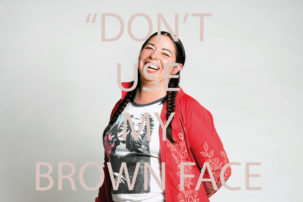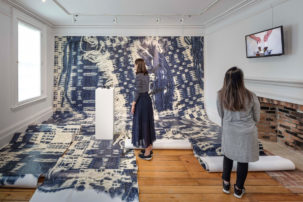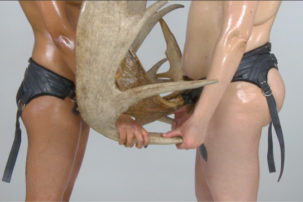Generously supported by RBC
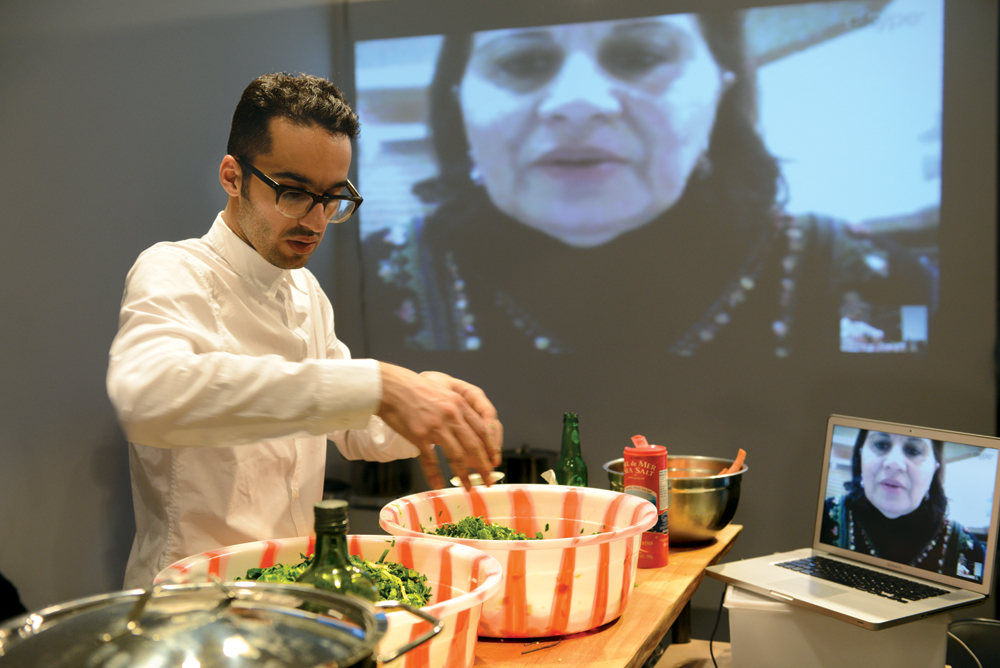 Basil AlZeri, The Mobile Kitchen Lab , 2013. Performance documentation. Photo: Henry Chan.
Basil AlZeri, The Mobile Kitchen Lab , 2013. Performance documentation. Photo: Henry Chan.
Basil AlZeri
An artist and art educator, Basil AlZeri creates performative home-spaces to express generosity and hospitality. In The Mobile Kitchen Lab (2012–16), he video chats with his mother, Suad, in Arabic while cooking in the gallery space, allowing side conversations between visitors to mingle with his culinary dialogue. Acknowledging the underappreciated labour of mothers, the artist demonstrates how the transmission of matriarchal knowledge becomes obstructed for immigrant families. In Push, Sort, Hang, Dry, and Crush (2014), the artist snips wild thyme and makes za’atar—according to his mother’s recipe—before an audience. He treats the preservation of culinary techniques as an act of resistance against colonialism. Allowing discursive interactions to occur naturally, AlZeri encourages conversations about food sovereignty and cross-cultural exchange through sharing a meal.
 D’Arcy Wilson, The Memorialist: Museology, 2015–16. Archival, ink-jet, print 58.4 x 87.6 cm. Photo: Chris Friel.
D’Arcy Wilson, The Memorialist: Museology, 2015–16. Archival, ink-jet, print 58.4 x 87.6 cm. Photo: Chris Friel.
D’Arcy Wilson
In her ongoing performance series The Memorialist (2015–), D’Arcy Wilson fashions herself as an accidental explorer, coming across the little-known history of zoology in Atlantic Canada. She investigates zoological specimens held in museum collections—in places like London, Oxford and Washington—and lovingly touches their preserved bodies or gives them a photograph of the outdoors. In previous works, she performed elegies for lost wildlife in parks or galleries in Nova Scotia, New Brunswick and Newfoundland. She has also composed lullabies for specimens at the Banff Park Museum. By retracing the thoroughfares of colonial expansion that displaced animals from Atlantic Canada to Europe, Wilson mourns the mistreatment of nature through collecting practices. Notes of neo-colonialism arise in artworks that focus on settler culture and use “exploratory” strategies. Wilson’s work could be understood as using colonial methods to explore colonial pasts. Her performances document an attempt to understand tragedy and the cognitive failure that comes with this impossible pursuit.
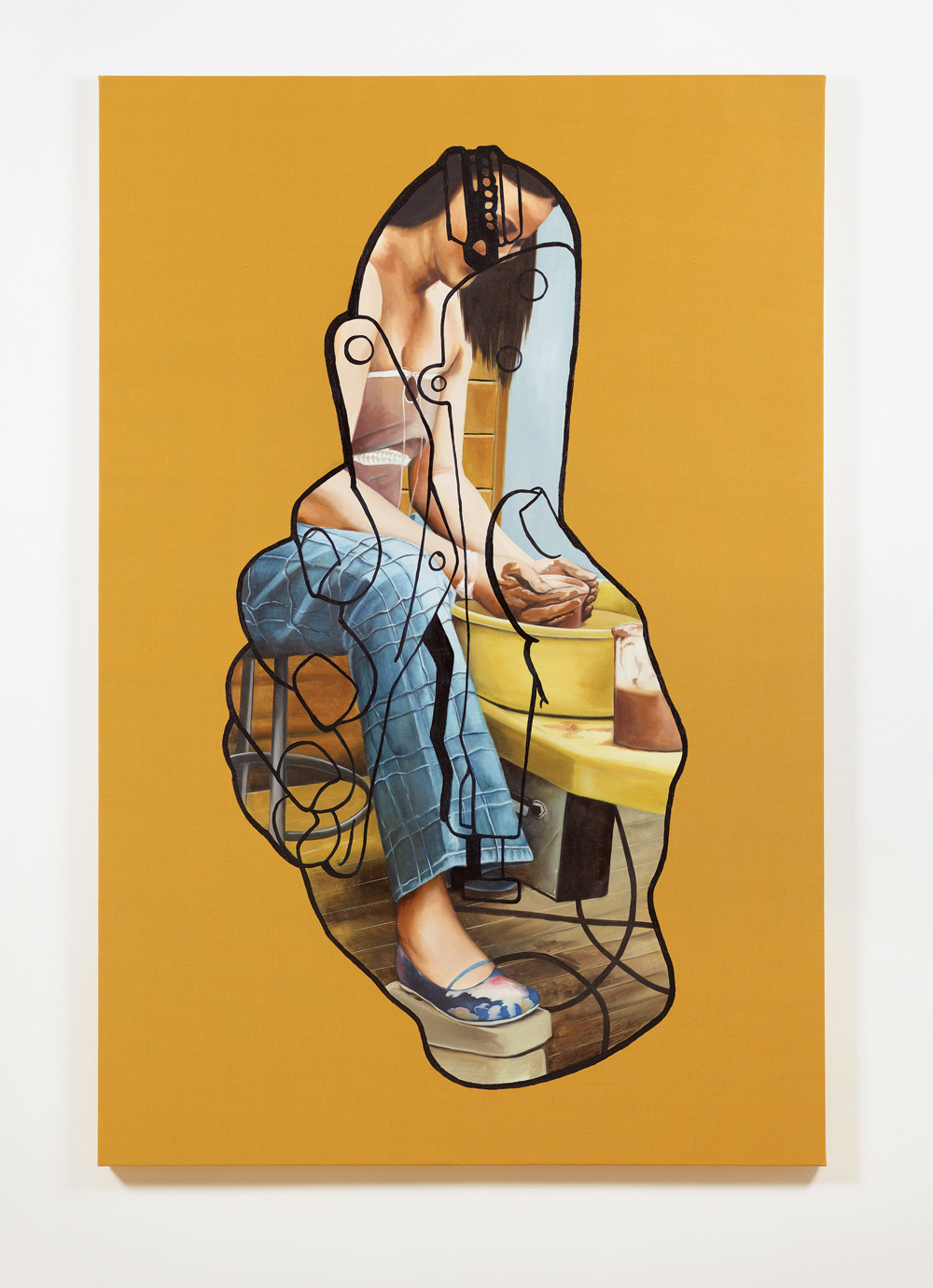 Stephanie Hier, Hardly Feel Like a Mustard Seed, 2017. Oil on linen, 1.83 x 1.22 m. Courtesy downs and ross, New York.
Stephanie Hier, Hardly Feel Like a Mustard Seed, 2017. Oil on linen, 1.83 x 1.22 m. Courtesy downs and ross, New York.
Stephanie Hier
Realist painting can turn cartoonish—after all, both are forms of hyper-representation. For Stephanie Hier, a finalist in the 2016 RBC Canadian Painting Competition, the two styles overlap and give back to each other. Her paintings bear the undeniable influence of Dutch Realism, but stretch beyond the traditional medium through the use of lumpy ceramic frames and temporary tattoos. A painted cluster of fruit is overlaid with a little cartoon paintbrush, cheekily gesturing back toward painterly influences. Ceramic cartoon gloves dot the floor, pointing perhaps at an element in a painting, or perhaps in no particular direction. The Toronto-born, New York–based painter has exhibited widely in established galleries and unconventional spaces, such as an empty storefront in Toronto’s Galleria Mall, and at Dead Horse Bay on the south shore of Brooklyn. Whether they are hung on a gallery wall, on wooden remnants of an old pier or on unfinished drywall, Hier’s paintings challenge conventions associated with two-dimensional images.
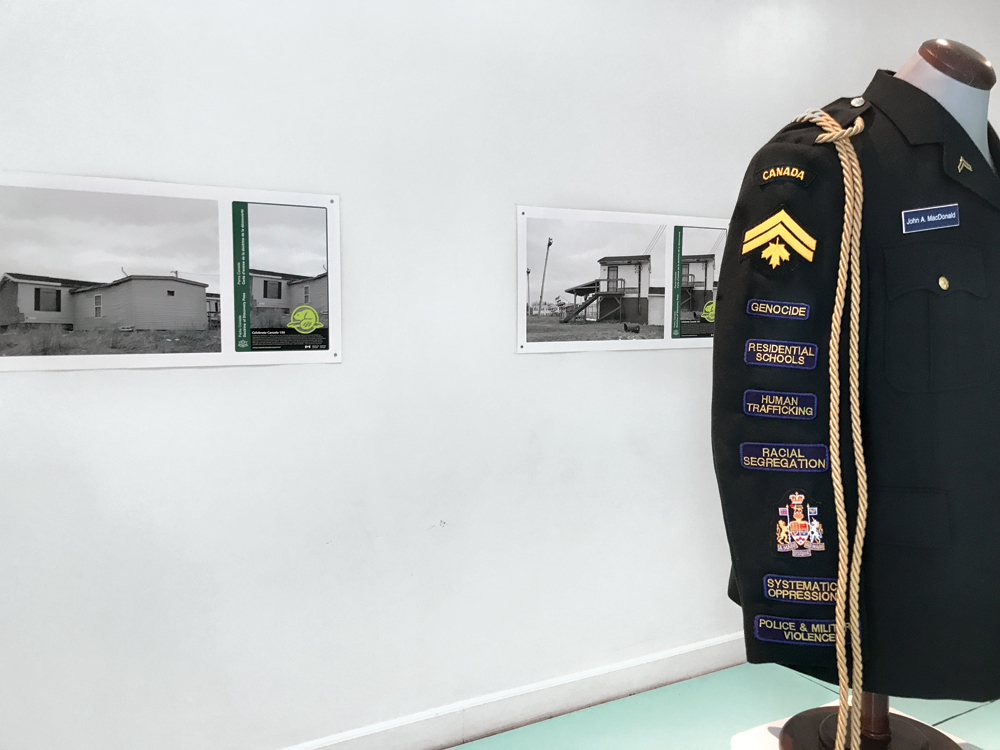 Installation view of Raven Davis’s “The De-Celebration of Canada 150” at the Khyber Centre for the Arts, 2017.
Installation view of Raven Davis’s “The De-Celebration of Canada 150” at the Khyber Centre for the Arts, 2017.
Raven Davis
Canada’s 150th birthday fell in the midst of Raven Davis’s “The De-Celebration of Canada 150” at the Khyber Centre for the Arts, an exhibition that critically examined Canadian nationalist propaganda. In a year marked by gratuitous tributes to Confederation, the Anishinaabe artist has been staging performances at memorial sites, landmarks and gallery spaces in response to the publicly funded celebration of colonial genocide. Davis’s artistic practice—with its focus on sustained interventions and durational actions—is in no way separate from their activism; when encountering Davis’s work, passersby might wonder whether they were witnessing a protest, a performance or a commemorative ceremony. Appropriately, all three apply. In 2016, the artist sustained a four-day Sacred Fire in Halifax’s Grand Parade, renaming it Grand Pray in commemoration of the young lives lost to suicide in Attawapiskat and other Indigenous communities. Davis’s practice relies on disruption and intervention, while simultaneously prioritizing prayer, healing and gathering.
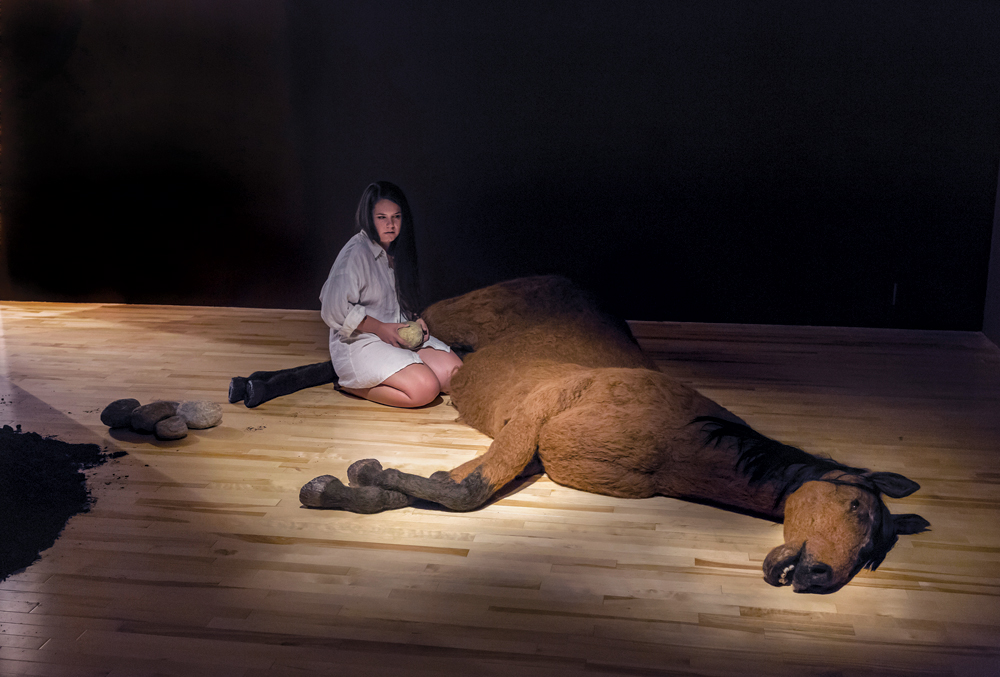 Vicky Sabourin, Warmblood, 2014–. Wool, earth, stones, vinyl print, rope and performance. Courtesy Galerie Trois Points. Photo: Guy L’Heureux.
Vicky Sabourin, Warmblood, 2014–. Wool, earth, stones, vinyl print, rope and performance. Courtesy Galerie Trois Points. Photo: Guy L’Heureux.
Vicky Sabourin
Vicky Sabourin’s life-sized dioramas act as theatrical sets for her performances. Her elaborate folk maquettes are constructed using antiques, found objects, photography, papier mâché and natural matter, creating a whimsical playground meant to incite desire and fear. Sabourin inserts herself into the sets—in the case of Warmblood (2014–) she crawls into a life-sized felted horse—making herself a character in a dark allegory. She also uses a particular French-settler visual language. At Manif d’art in Quebec City this spring, she mimed paddling motions while sitting in a boat-like armoire and wearing a striped-wool blanket. Her performance work acknowledges the historical erasure and misrepresentation of women in folk tales, as well as the ongoing privatization of wilderness.
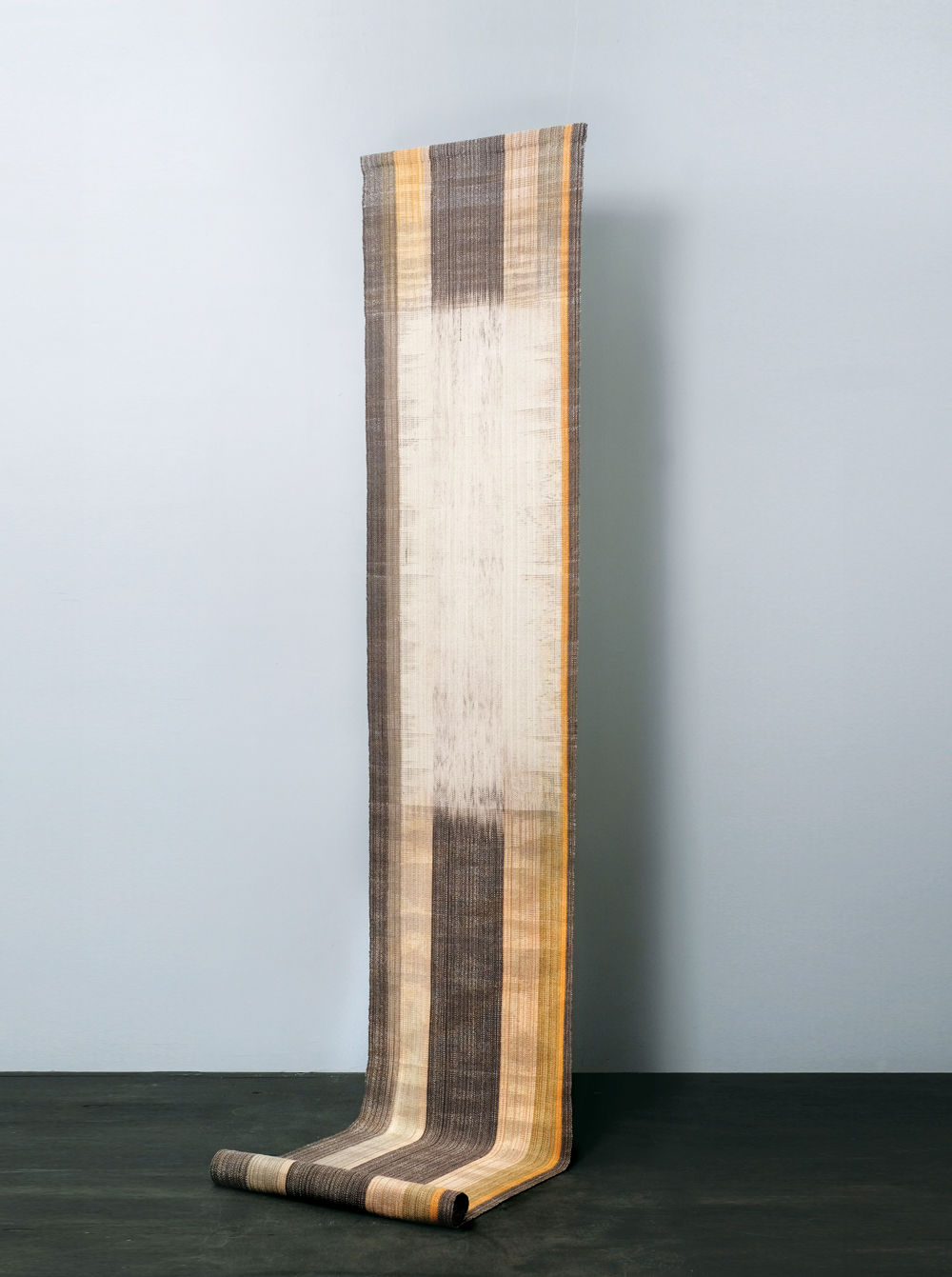 Anna Heywood-Jones, Vestiges, 2015. Wool, silk, American elm, goldenrod, hammered shield lichen and staghorn sumac, 2.27 m x 55.9 cm x 55.9 cm. Photo: Byron Dauncey.
Anna Heywood-Jones, Vestiges, 2015. Wool, silk, American elm, goldenrod, hammered shield lichen and staghorn sumac, 2.27 m x 55.9 cm x 55.9 cm. Photo: Byron Dauncey.
Anna Heywood-Jones
Anna Heywood-Jones tests the dyeing properties of plants through practice-based research in dyeing and weaving. She builds regional lexicons of colour through trials and studies, exploring the ways in which plant life bears the marks of history. Vestiges (2015) is a textile installation that explores “spaces of temporary neglect,” specifically the site of St. Joseph’s Church in Halifax’s North End. Heywood-Jones dyed fibres using plants that grew where the church was demolished in 2009, before the site was excavated in 2015, and in doing so highlighted both the rapid pace of gentrification in the area as well as the clumsiness and inefficiency of expansion. Bearing witness to the passage of time, Heywood-Jones acts as a geologist, a textile artist and a botanical archivist.
 Erika DeFreitas, A Visual Vocabulary For Hands in Mourning (no. 65), 2013. Digital ink-jet print, 45.7 x 30.5 cm. Photo: Daniel Ehrenworth.
Erika DeFreitas, A Visual Vocabulary For Hands in Mourning (no. 65), 2013. Digital ink-jet print, 45.7 x 30.5 cm. Photo: Daniel Ehrenworth.
Erika DeFreitas
Erika DeFreitas often collaborates with her mother. Her performative actions explore habits of ritual, and her portraits visualize moments of penitence. A Visual Vocabulary for Hands in Mourning (2013) acts as a study, recreating common postures that hands take up in times of grief. Her 2016 exhibition at Toronto’s Gallery 44 featured portraits of her mother weighed down by 300 beaded rosaries, which the two women had strung together by hand. Her use of textiles extends to her series Teleplasmic Study with Doilies (2010–11), in which DeFreitas uses her mother’s and grandmother’s doilies to mimic archival images of seances in 1920s Winnipeg, which show fabrics emerging from participants’ mouths. In these seances, lost loved ones animate the fabrics through spiritual intervention, and in her versions, DeFreitas positions herself in reverence under the weight of her ancestors’ labour.
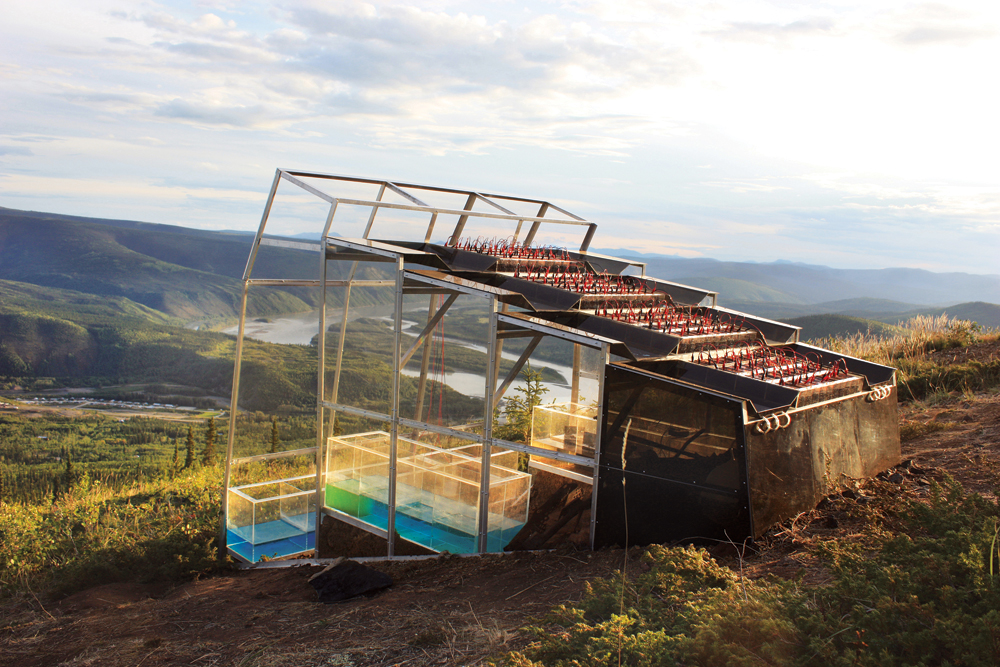 Colin Lyons, Time Machine for Abandoned Futures, 2015. Gold rush artifacts, Plexiglas, aluminum, copper sulphate,soda ash, copper plates, zinc plates and wire, 2.74 x 4.27 x 2.44 m.
Colin Lyons, Time Machine for Abandoned Futures, 2015. Gold rush artifacts, Plexiglas, aluminum, copper sulphate,soda ash, copper plates, zinc plates and wire, 2.74 x 4.27 x 2.44 m.
Colin Lyons
What appears to be a space-age rainwater-collection system outside of Dawson City, Yukon, is actually a prototype for a low-tech artifact-conservation unit. In 2015, Colin Lyons created Time Machine for Abandoned Futures, an inefficient off-grid lab with a battery powered by etching acid, designed to clean industrial objects scavenged in an area that witnessed decades of dredging. Lyons was born in the rust belt of Windsor, Ontario, and he highlights the impermanence of industry by creating anti-monuments to the ruins of North America’s manufacturing past. In 2013, his kinetic sculpture The Conservator was installed in the Soap Factory, a former warehouse complex reclaimed for the arts in Minneapolis, Minnesota. Lyons’s machine polished a rusted I-Beam in the gallery. The work points to society’s attempts to sanitize industrial heritage sites for urban renewal, and the artist’s chemical experiments reference his training as a printmaker. He takes etching chemicals beyond their traditional boundaries and acknowledges the role of printmaking in heavy-duty art production.
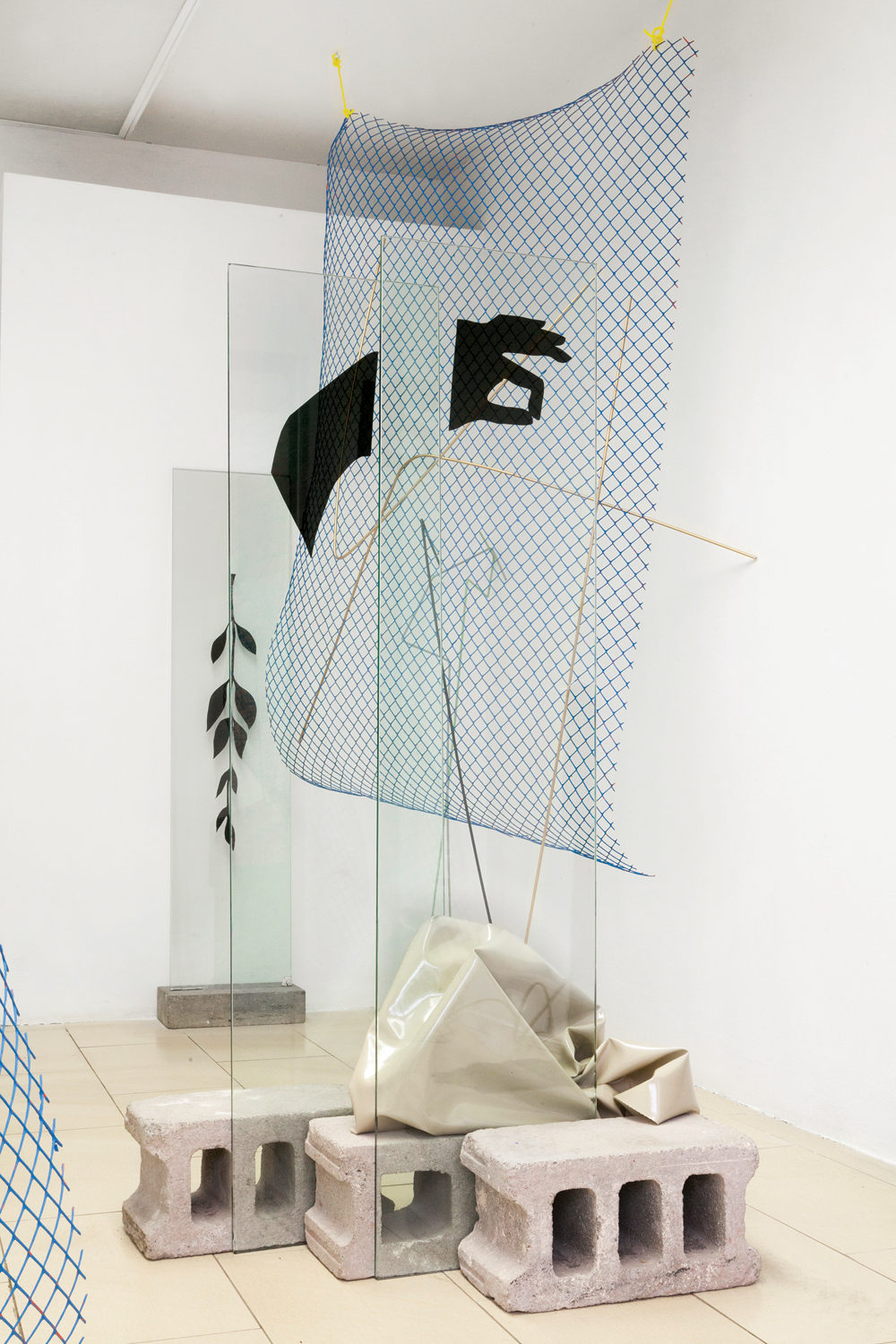 Azza El Siddique, a/s/l, 2017. Glass, privacy film, cinder blocks, vinyl, safety netting, latex paint, plastic cord, thermoplastic, spray paint and hydrocal, dimensions variable. Photo: Yuula Benivolski.
Azza El Siddique, a/s/l, 2017. Glass, privacy film, cinder blocks, vinyl, safety netting, latex paint, plastic cord, thermoplastic, spray paint and hydrocal, dimensions variable. Photo: Yuula Benivolski.
Azza El Siddique
In her recent exhibition “Lattice Be Transparent,” Azza El Siddique tapped into the nostalgic properties of scent. In the basement of 8eleven Gallery, drips of water fell onto a pile of henna. Surrounding this installation were burning pots of Bakhoor (incense), an aroma that elicited a powerful sense of recognition in the artist when she encountered it in a store in Toronto. The materials in El Siddique’s sculptural assemblages act as clues that point toward memories of her past, traits of her family and details of her diasporic experience as a Sudanese Canadian. At first glance, her assemblages of fabrics, mesh and concrete blocks appear to be abstract material explorations in form and balance. But for El Siddique, each element specifically references an incident or story. She works with rigid materials in a way that makes them appear pliable and fibrous, referencing her father’s work as a pulp-and-paper scientist. Acting as sculptural portraits, her works demonstrate a nuanced approach toward visualizing personal history and family ancestry.
 Chun Hua Catherine Dong, I have been There – Manchester, 2016. Performance and photography. Photo: Ines Valle.
Chun Hua Catherine Dong, I have been There – Manchester, 2016. Performance and photography. Photo: Ines Valle.
Chun Hua Catherine Dong
As a regular participant in biennials and festivals worldwide, Montreal-based Chun Hua Catherine Dong is positioning herself as a key player on the international performance art circuit. On the heels of her exhibition “Visual Poetics of Embodied Shame” at Ace Art Inc. in Winnipeg, she is preparing for another solo exhibition at Modern Fuel in Kingston in 2018. Every time the artist travels she builds on the ongoing series I have been There (2015–), in which she lies on the ground covered in Chinese silk-brocade fabric. It is customary in Dong’s hometown in China for daughters to cover their lost elders in this manner, and given her uncertainty as to whom she will be buried by, she opts to bury herself—publicly and repeatedly. In To Begin (2016–), she struggles to hold a pile of history books, repeatedly dropping them and recording the exact time of her failed attempts. Highlighting the inevitability of collapse in today’s sociopolitical climate, Dong’s repeated failures cause a momentary release, and her durational performances investigate how the body acts as a mediator throughout time and space, and across borders.
This post is adapted from the feature article “Looking Back,” generously supported by RBC in the Fall 2017 issue of Canadian Art. RBC is passionately committed to supporting emerging artists across Canada and internationally, and is proud to partner with Canadian Art on this Spotlight series.
To get every issue of our magazine delivered to your door before it hits newsstands, visit canadianart.ca/subscribe.

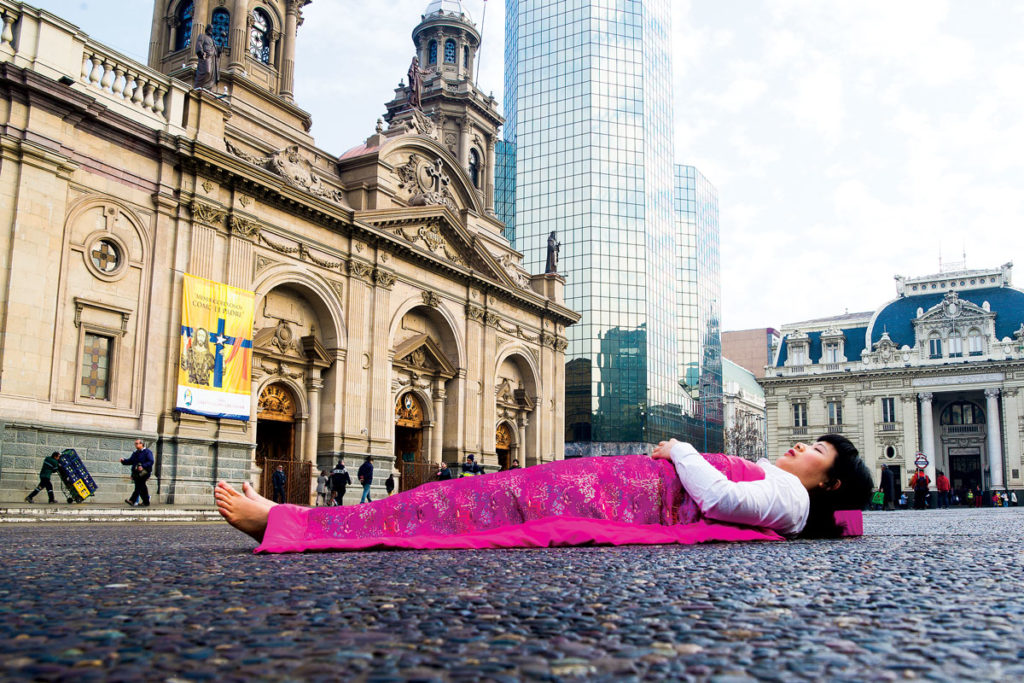 Chun Hua Catherine Dong, I have been There – Santiago, 2016. Performance and photography.
Chun Hua Catherine Dong, I have been There – Santiago, 2016. Performance and photography.

